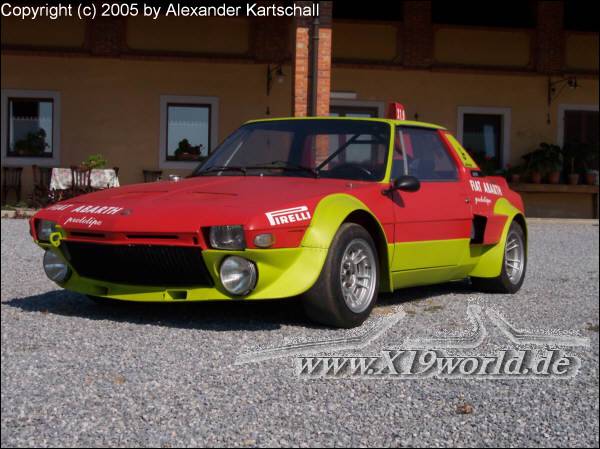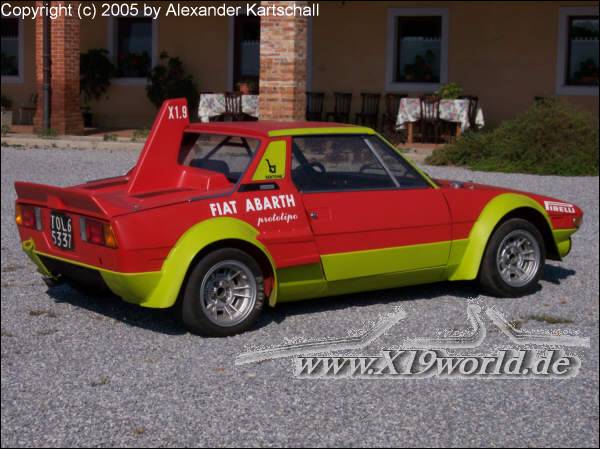Hi,
I will try to make a little summary about the "life" of the X1/9 Abarth Prototipo... to understand how it came to this car, I will start with the 124.
In the early 1960ies some teams were successful with the 124 Spider in Rallies, because of this Fiat found a small rallye team to ensure an adequate supply of spare parts for these teams. In 1970 Fiat found a semi-profesional rallye department ("Reparto Corse") with drivers and co-drivers, in 1971 Giovanni Squazzini proposed to buy Abarth for this rallye team, what they did in October 1971. In 1972 the rallye department moved to the Abarth factory at the Corso Marche in Torino, the result was the Fiat 124 1600ccm that was released in the same year. Also in this year Abarth started the development of a special rallye car on the basis of the 124, with the engine of the 132 (132AC4) with 1756ccm. This car was shown first at the auto show in Geneva and started for its first race at the TAP Rallye Portugal as "Fiat 124 Abarth Prototipo". In January 1973 the 500 units for the homologation were produced so that this car was able to start in the former "group 4" regelement. In the same year they developed a 16V head for this engine (Abarth 232) and an engine with 1840 ccm with 16V head (Abarth 232G), Gino Macaluso was appointed to the "sporting director" of Abarth.
Sergio Limone told us, that Fiat/Abarth were looking for a replacement of the 124 because of the superiority of the Lancia Stratos. The car should have a similar design as the Stratos, so they choose the X1/9 that was introduced in the end of 1972 and the X1/20 (later Montacarlo, Scorpion in the US) that was still in the development at Fiat. They got for the X1/9, because it was lighter and faster than the X1/20. This one was driven as Abarth 030 at the Giro d'Italia in 1974.
In 1973 Abarth got a X1/9 for developing a rallye car. The chassis was one of the show cars that was shown at Sicily in November 1972. They installed the 1995 ccm engine from the X1/20 and a 5-speed-gearbox of the Lancia Beta Coupe group 4, modified the brakes and experimented with various suspensions. After successful tests that were done by Giorgio Pianta they decided to get some experience in rallies, so they started at the rallye Sicilia in March of 1974. Pianta told us, that they installed an Abarth 232 engine (1756ccm 16V) short before the race. 50m after the start a drive shaft was broken so that they had to stopp... They experimented with the 232 and 232G engine parallel to the 124 Abarth project, you can see in some pictures that a 124 was standing beside a X1/9 at a race track, where engine parts were changed from one car to another. Fiat tested at the race tracks of Casale and Mugello.
In the second rallye, the Rally 4 Regioni, they had problems with the gearbox so that they had to stopp this race in the second stage. After this rallye they made many tests, the result was the first place at the Rallye delle Alpi Orientali in June 1974. They did show to the bosses of Fiat that the car was competitive, so they were able to order 5 more chassis in the summer of 1974. The first chassis, TO H02940 #133, was the "experiental car" of the X1/9 Abarth, because of this I call it the "porotype of the Prototipo". The three other race cars were built with all the experience Abarth made with TO H02940. Three more cars were registered in September 4th 1974 with the number plates TO L65335 (#23002), TO L65336 (#23003) and TO L65337 (#23001). One more chassis became the Stradale, the sixth chassis was a "spare chassis". The first race of the three new race cars was the Tour de France Auto in September 1974, after this event the cars were basically modified again and TO L65335 and TO L65336 started at the Giro d'Italia in October 1974. They participated in various rallyes until the rallye season finished in the end of November 1974, in the same month the car was shown at the Torino Motor Show. In the meantime they built a Stradale version, that has to be built for 500 units until February 1975 for the homologation in group 4. Bertone started to produced parts for the Stradale, Mr. Panicco told us that they made some hundred aluminium hoods, doors, wing extensions and many more parts.
In the meantime the Rallye team was going to France, where they tested new tires of Michelin in various rallies. The driver was Bernard Darniche with his co-driver Alain Mahé, they won most of the rallies they entered. Darnice, who also drove the Stratos, said that the handling of the X1/9 was better than that of the Stratos.
In the meantime the Fiat bosses decided, that the sporting image of the Fiat/Lancia concern should be formed with the marque Lancia and the Stratos, and that Fiat should be formed to a "family car" manufacturer. The X1/9 was sold good, but Fiat had problems to sell the 131. So they decided to stopp the X1/9-Project and use instead the 131 for the rallies. At this time Gino Macaluso was on the way to the commitee for issue the homologation. He told us, that one evening before the hand-over of the homologation form he became a telephone call from Torino to come back. There he heared about the stopp of the project and was so disappointed, that he left Fiat/Abarth and went back to work as architect. Bertone was ordered to destroy all he has produced for the X1/9 Abarth, instead of this he has got the order to produce the 131 Abarth.
After the stopp of the Project Abarth developed the 131, which had a similar engine that was planned in the X1/9, but was never raced in the X1/9. The 1995ccm 16V engine is completely different to the 1840ccm 16V engine, but the basics were developed in the X1/9.
After The Project was stopped, Fiat sold the cars. TO H02940, TO L65335 and the Stradale were bought by Al Cosentino (not at the same time), TO H02940 and TO L65335 later sold to a collector in Japan. TO L65336 was sold to Italy and was raced one more time at the Giro d'Italia in 1980 with Dallara wing extensions, after that it was raced at many slalom events in Italy and won the italian "super slalom" championship in 1983. In the end of the 1990ies it was sold to Gino Macaluso, the former sporting director of Fiat/Abarth and this man, who drove the same car at the Giro d'Italia in 1974. He fitted an Abarth 232G engine again.
TO L65337 was sold to another collector and rallye driver in Italy, he drove one rallye and some autocross events. In the 1980ies the car was restored and fitted with a 16V Abarth 232G engine.
The evidence of all what I write are interviews with Giorgio Pianta, Gino Macaluso, Sergio Limone, Guiseppe Volta, Gian Beppe Panicco, Clay Regazzoni, Al Cosentino, many hundrets of pictures, many documents like the vehicle titles or the homologation form, informations from the archives of Fiat and Bertone, drivers, mechanics and owners of the cars after the time at Abarth.
I took many, many years for the research of the history of these cars, in the end I met Roberto Motta who was able to open doors to Fiat, Abarth and all the people who were working at and with this cars in this time. One of my biggest dreams became true, as I was able to see an original X1/9 Abarth Prototipo driving in front of me, to hear the sound of this engine, to hear the sound of the gearbox, to smell it's exhaust gases, to make some hundret pictures of it, to sit in it, to lie under it... it was an amazing experience

Ciao, Alex



